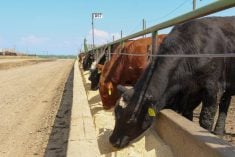Alberta fed cattle prices dropped to a two-year low of $143 in late June as the beef complex absorbed the larger production. Cattle-on-feed inventories continue above year-ago levels, enhancing the weekly slaughter volumes.
Wholesale beef prices have come under pressure and we are starting to see weakness in the retail market. Wholesale and retail beef prices have held up fairly well as packers and grocers struggle to maintain high margins. However, we are now starting to see retail prices ease as the expected surge in third-quarter beef production comes to fruition.
Read Also

Harvest wraps up and fall work begins
At the Eppich famly ranch in western Saskatchewan, the fall harvest was successful with few breakdowns, cows and calves have been sorted and a new tractor has arrived
Consumer demand has exceeded expectations, tempering the decline in the beef market. Weather has been favourable for the grilling season; people are travelling and eating out as hotel occupancy rates are at nine-year highs. The U.S. economy is running full steam with low unemployment and the tight labour market has resulted in a marginal increase in hourly wages. This all bodes well for enhanced consumption but the market in general is functioning to encourage demand at the current price levels.
The numbers
U.S. cattle on feed as of June 1 reached 10.8 million head, up two per cent from year-ago levels. Fed cattle marketings in May were up five per cent from last year while placements were a whopping 10 per cent above May of 2015. U.S. weekly beef production has been exceeding last year by nearly eight per cent over the past few weeks, confirming the increase in quarterly beef production.
The USDA continues to project a 360-million pound year-over-year increase in third-quarter beef production. In the final quarter, beef production will start to decline but will remain above year-ago levels by nearly 215 million pounds. The 2016 U.S. calf crop is projected to be one million head above 2015 (slightly above my earlier projection). For next year, there are sharp year-over-year increases in each quarter; however, the tightest supply scenario will likely be in the March April period.
In Canada, lower feeder cattle exports this spring have caused June 1 cattle-on-feed inventories in Alberta and Saskatchewan to reach 839,000 head, up four per cent from June 1 of 2015. Canadian year-to-date beef production for the week ending June 18 was 455,000 tonnes, seven per cent above year-ago levels. At the same time, fed cattle exports to the U.S. are up 44 per cent over last year at 142,000 head as of June 11. In Canada, the market is functioning to encourage exports of fed cattle along with fresh and chilled cuts.
U.S. away-from-home food spending during May was up 7.8 per cent over May of 2015 while at-home food spending was up 3.4 per cent. The industry is looking for similar year-over-year increases in June and a potential surge in July during the peak holiday season. However, demand tends to slow in August and then drops off in September, which is a seasonal low. Keep in mind this demand seasonal low is when weekly beef production will reach a peak high for the year.
Feeder prices struggle
Feeder cattle prices are struggling given the ongoing financial bleeding in the finishing sector. The prolonged period of negative margins has lowered the purchasing power for the upcoming fall. In the short term, I see further pressure on feeder cattle prices and the market is expected to trend lower into the fall.
However, I want to reiterate a few points from my previous article. The surge in third-quarter beef production will drive fed and feeder cattle prices to yearly lows. This is when feedlots will want to load up on yearlings to hit the peak fed cattle market in March and April of 2017. However, cow-calf producers do not want to sell during the third and fourth quarters. This will be the year to background your calves and sell them in the first quarter of 2017 when feeding margins improve.
I always like to think about potential ‘black swan’ variables. The Brexit is likely overblown and professionals adjusted accordingly. However, the most notable problem in the short term is China’s rising debt. Financial meltdowns tend to occur in the fall, which could add pressure to the weak fundamental structure for the beef complex.

















